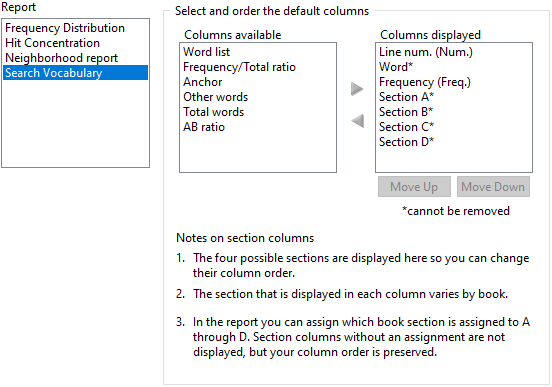User Preferences
Updated as of 24 August 2020.
View
You can adjust some of the display features used throughout the program.

| Option | Description |
|---|---|
| Hotspots in graphics | Some images have hotspots within the graphics. By turning this on, you'll see rectangles on top of graphics with hotspots on them. These hotspots have hyperlinks associated with them. |
| Hidden books in the Library | Some books and graphics are used as support files and are hidden. By turning this on, you'll see hidden files within the library view. |
| Abbreviations in citations when available | Some books have an optional abbreviated citation for parts of the table of contents. This option will use the abbreviations when available. (Recommended) |
| Spell Checker | The spell-checker is a drop-down list of words that are closest to the word you are typing. If a word is not found in the book you are searching, it does not appear in the spell-checker. (Recommended) |
| Part of speech markups | In books that have part of speech tagged, you can view the part of speech markup above the word in the Viewer. This does toggle the display within the WordWheel, Neighborhood Report, Search Vocabulary Report. |
| Primary parts of speech only | Part of speech codes are usually cryptic to most users. Turning on primary parts of speech will hide any information besides whether the part of speech is a noun, verb, etc. |
| Primary parts of speech colors | Primary parts of speech have been given default colors. Turn this on for color distinction between colors. |
You can change the current program language between German, English, Spanish, French, Portuguese, and Japanese. Any change will not take effect until the program is restarted.

Workspace
You can toggle the display of the various tool windows listed.

You can choose whether you would like a link clicked within a book to open in the same window as the book (thus replacing the book in the active window), or if you would like to open a new window with the linked content whenever a link is clicked.

This option is identical to 'Text link mode,' except for graphics instead of links.

Search
Use this menu to toggle which columns are visible in the WordWheel within the Search window. These options can also be toggled within the WordWheel itself by right-clicking along the top of the WordWheel window.
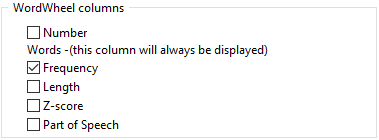
For Word-List reports related to high-frequency or low-frequency words, you can modify how many words are shown on the horizontal bar graphs. Both charts can show up to 10,000 words. Scrolling will lag when this number is changed to 10,000.

In the Book Viewer window, you can double-click on a word to search for that word. Checking this option will disable this feature.

Output
Each vertical bar witin the Vocabulary Dispersion Report represents a certain amount of words. You can change this from 1,000 to 10,000 words. Note that smaller texts may not have enough words if this is changed to 10,000 words.

You can choose to copy or print all possible items from this report. This option can lag a little if there are thousands of reference levels to copy. Otherwise, you can choose to copy or print only those items that are currently visible on the report.

You can choose to print hotspots on certain graphics that allow for linking to other media/texts. You can also choose how large you would like graphics to display: 1) scaled to fit the current page or 2) display in their original size.

These options allow for customized output options when copying and exporting information from Search Results. You can choose whether you would like the citation for a search hit to be before or after each reference, as well as if you would like to use abbreviations where possible.
You can also choose how many words/references you would like to include before or after the search result. This can help to give context to the search result rather than just copy the individual word or phrase.
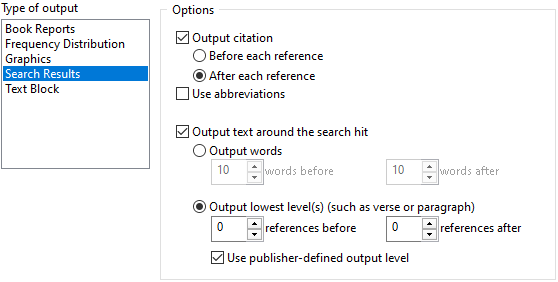
You can specify whether or not you want the citation to appear when you copy or print text and whether you want it to appear before or after the text block.
You can specify whether or not you want the notes attached to the text block (if any) to be copied or printed with the text block.
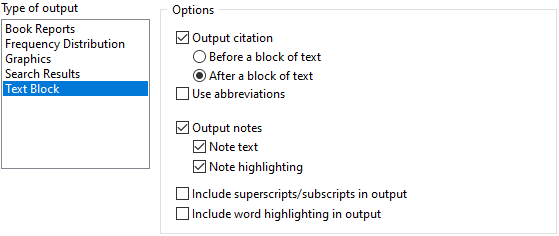
Book Reports
You can change the colors the Vocabulary Dispersion report uses to display word frequencies. Additionally, you can choose which columns display in the Vocabulary Dispersion report. These columns can also be toggled within the Vocabulary Dispersion report by right-clicking along the top of the Vocabulary Dispersion report data window.
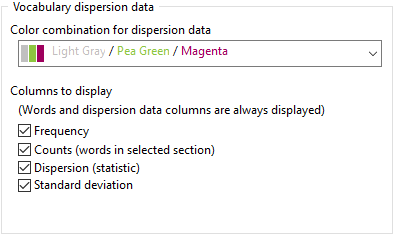
These colors are used as the color scheme for the Vocabulary Dispersion report. Some have been chosen to aid those with color blindness. The left color indicates less than expected. The middle color indicates more than expected. The right color indicates more than twice expected.
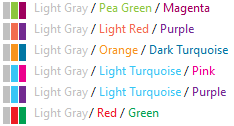

Search Results Reports
You can choose whether you would like to display all entries, whether they have hits in the results or not. You can also choose which columns are to be displayed in the report.
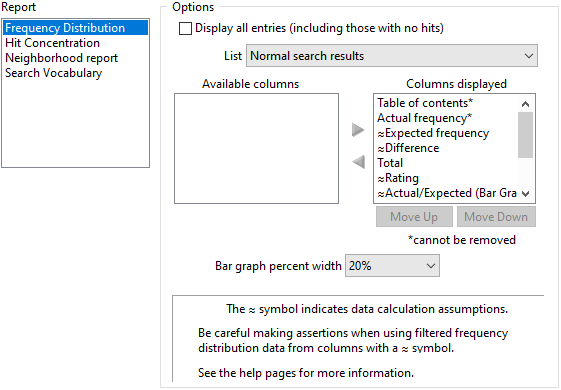
When determining search hit concentration, you can either have it limited to the lowest-level reference, which is usually a verse or paragraph. Alternatively, you can limit it to a set range. You can pick a range width of 3 to 15 words, and the word threshold necessary to display any output.
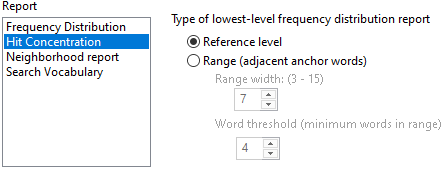
If you set the range width to 7 and word threshold to 4, then it will show you results where 4 of your search hits must occur within a 7-word window.

Neighborhood Settings
By default, neighbors and neighborhoods analyze five words before and after the search word. You can set the window from 0 to 10 in either direction.
The Neighborhood Report ignores paragraphing, so it analyzes words from surrounding paragraphs if the search term is near the beginning or end of the lowest level (usually a paragraph). The Do not cross lowest-level bound with neighborhoods checkbox will enforce that neighborhoods must be within the same lowest level. Note: Loading the report will take longer with this turned on.

Neighbors Settings
Options to ignore case, diacritics, and part of speech (if applicable) are available.
You can use the uncorrected statistics to calculate neighbors. See the PDF here about statistics used in WordCruncher for more information.

Friends Settings
The default settings for friends (the strongest neighbors) are calculated by a statistic called Mutual Information (MI). This statistic tends to show the best results, but there are several other statistics used for calculating friends. See the PDF here about statistics used in WordCruncher for more information.
Available Statistics: Dice, Expected, LL, Log Dice, Log Ratio, MI, MI2, MI3, MS, Percent, Rating, T-score(o), T-score(pq), Z-score(e), Z-score(pq), ΔP k→n, and ΔP k←n
To be counted as a friend, a word must have 1) a minimum threshold based on the statistic used (default 3 for MI) and 2) a minimum sample frequency (default 2).

You can choose which columns display in the Search Vocabulary report. These columns can also be toggled within the Search Vocabulary report by right-clicking along the top of the Search Vocabulary window.
